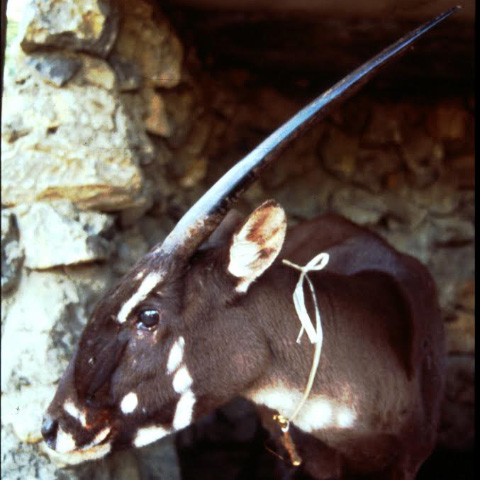Conservation Actions
This species is listed in CITES Appendix I, and is legally protected in all range states. If the species is still extant it is most likely to be in eastern Cambodia in one of four protected areas (Lomphat Wildlife Sanctuary, Phnom Prich Wildlife Sanctuary, Mondulkiri Protection Forest and or Siema Biodiversity Conservation Area) (Timmins and Ou 2001, R.J. Timmins pers. comm. 2008, AWCSG 2011). There are no Kouprey in captivity, one existed in Vincennes Zoo, Paris, in 1937 and survived for about five years. There have been suggestions that domesticated Kouprey may survive in Cambodia (Hassanin et al. 2006). However this seems unlikely (R.J. Timmins pers. comm. 2008) and recent analysis of several nuclear genes revealed that a domesticated specimen was a hybrid between female Kouprey and male Bos taurus (Handschuh and Hassanin 2013).It is unlikely that specific survey work for Kouprey would produce any better evidence than has already been documented, and the best conservation measures for the species now would be to concentrate on in situ protection activities for large mammal communities in eastern Cambodia, especially building upon and strengthening the existing projects within the Srepok Wilderness Area of the Mondulkiri Protection Forest and the Siema Biodiversity Conservation Area (AWCSG 2011).
Location Information
The historical distribution of this species was Cambodia, southern Lao PDR, southeast Thailand, and western Viet Nam (Grubb 2005). However, there is no recent (post-1970) confirmation in any of these countries and because of the obvious major declines in all congeners in this region in this period, this species is now thought to be possibly extinct.Geographic Range
Possibly Extinct
Cambodia, Lao People's Democratic Republic
Population Information
At an international workshop, held in Viet Nam in January 1988, reports were presented which suggested that there were about 27 Koupreys in Viet Nam, possibly 40-100 in the Lao PDR, and up to 200 in Cambodia, with perhaps a seasonal presence of a few animals in Thailand. These figures, which were little more than guesses, suggested that a total of about 100-300 Koupreys still existed in the late1980s. Unfortunately, it now seems that these figures were too optimistic, especially for Lao and Viet Nam where surveys in the 1990s were unable to document even large significant populations of other species of wild oxen (Cox et al. 1991, 1992; Duckworth et al. 1994, 1999; Le Xuan Canh et al. 1997; Duckworth and Hedges 1998; Evans et al. 2000; Cox et al. 1991, 1992; Le Xuan Canh et al. 1997). Numbers of wild oxen were, however, much higher in Cambodia, even though, within the vast extents of habitat, their densities were already low as documented during an aerial survey of a large part of eastern Cambodia in 1994 (Olivier and Woodford 1994).The last published records of Koupreys are those of C. Wharton, who lead an expedition to capture Koupreys in 1963/64 (Wharton 1966). In 1969, J. Mellon saw two female Koupreys in the Chhep/Melouprey area of Cambodia, and in 1993 he was of the opinion that there might still be Koupreys in the area (J. Mellon in litt to D. Ashwell 1993). Later reports were also received by Pfeffer (1974 in litt. to IUCN/CMC). In the 1964-1970 period, Pfeffer undertook five expeditions to Indochina (each three months long) during which he collected information about kouprey and "took the only reasonable photograph of a wild kouprey" (Kemf 1988, Pfeffer and Ou Kim-San 1967, Pfeffer 1969). None of the evidence for Koupreys since Mellon's time, based on second-hand reports, hearsay, equivocal track identification or trophy horns (found in villages or wildlife markets and which could plausibly date back to Wharton's era) (e.g. MacKinnon and Stuart 1989, Duckworth and Hedges 1998, Duckworth et al. 1999, Timmins and Ou 2001, Timmins et al. 2003), has been particularly convincing in suggesting that viable populations of Koupreys remain; rather it suggests that a very rapid demise occurred. Wharton (1957) observed Koupreys to occur, even in what was considered optimal habitat, in lower numbers than Banteng Bos javanicus (his figures and other observations suggest a ratio of somewhere between 1:2 and 1:10), and suggested that, because of their restricted range and habitat specificity, Kouprey was at elevated risk of extinction compared with the other wild cattle.
Extensive survey work has now documented where significant wild cattle populations remain within the historical range of Kouprey, and in no area other than eastern Cambodia are wild cattle numbers high (Timmins and Ou 2001, R.J. Timmins pers. comm. 2008, AWCSG 2011). In most areas wild cattle numbers are so low (low dozens of individuals scattered through hundreds of square kilometres of habitat) that it is no longer conceivable that Kouprey could survive (Le Xuan Canh et al. 1997, Duckworth and Hedges 1998, Timmins and Ou 2001, Timmins et al. 2003, RJ. Timmins pers. comm. 2008). An assessment of 90% of camera trap photos from the region including the potential range of the Kouprey was made in 2011 (AWCSG 2011). Although Banteng, Wild Water Buffalo Bubalus arnee, and Gaur Bos gaurus were all recorded from the region, there were no camera trap images of Kouprey. A careful gap analysis of potential Kouprey sites was part of the first step of the study, but not all the relevant data could be examined. The majority of images from at least seven projects known to have captured wild cattle were not reviewed. This included two sets of photos from potentially important areas of eastern Cambodia. None of the landscapes assessed were sufficiently surveyed to rule out the presence of Kouprey, and for the foreseeable future, it will be impossible to identify every remaining individual wild ox to species in such areas. But there are no defensible grounds for considering the population of Kouprey to be anything other than negligible in such areas (single individuals or 2-3 animals), primarily because of the naturally lower densities of Kouprey compared with Banteng, the habitat specificity of Kouprey and its exceptional value in trade (Wharton 1957, Timmins and Ou 2001, R.J. Timmins pers. comm. 2008, AWCSG 2011).
In eastern Cambodia there has now been substantial survey work (including observation-based field surveys and camera-trapping) which has documented hundreds of both Banteng and Gaur and even small numbers of Wild Water Buffalo (R.J. Timmins pers. comm. based on WCS and WWF unpublished data; T. D. Evans and T. Clements pers. comm. 2008, Gray and Phan 2011, AWCSG 2011). This, in addition to suggesting Kouprey really has been hunted out, gives good numerical grounds to be confident that kouprey (historically the rarer species) no longer occurs in the ratio found by Wharton and that Kouprey declined significantly faster and was almost certainly less resilient to hunting than are the other species (R.J. Timmins pers. comm. 2008). Certainly fewer than 5,000 wild cattle now survive within the historical range of Kouprey, 90% or more of those within Cambodia and the majority of those within the eastern provinces (R.J. Timmins pers. comm. 2008). If Kouprey still survives, it is certainly only as individuals (not functional groups) in very low numbers; its extinction, if not yet upon us, is almost certainly sealed. Therefore future recommendations focus on protection of areas with the highest probability of harbouring Kouprey that are also high priority sites for other wildlife species, and further review of camera trap photos; rather than further survey efforts (AWCSG 2011).
Threats
Hunting, both for local consumption and for trade (meat and body parts, especially horns and skulls), is (or, if the species is extinct, was) the major threat throughout the Kouprey's range (Duckworth and Hedges 1998, Timmins and Ou 2001, Tordoff et al. 2005). This trade value pre-dates the meteoric rise in volume and financial value of wildlife trade out of Lao PDR, Viet Nam and Cambodia during the 1990s and 2000s. Salter et al. (1990) found three sets of male and two sets of female Kouprey horns (all reportedly from Cambodia) in a village in southern Champasak Province (southern Lao PDR). The male horns were valued by the owner at USD 4,000 and the female horns at USD 1,600 per set. During a trip to Amphoe Muang (Mukdahan Province, Thailand, on the border with Lao) on 29 March 1991, Kouprey parts were found to be available at one vendor. Horns were not on display but customers could examine photographs in an album: female Kouprey horns were offered at USD 6,000-8,000 per pair and male horns at USD 2,000 per pair. The male horns were polished so that the shredded ends could not be seen. During a second visit (in July 1991) the same vendor's stall was less active and no Kouprey trophies were on offer (although Gaur and Banteng could still be ordered). Wild cattle trophies were on offer at other vendors but no Kouprey horns or skulls were for sale at these stalls (Srikosamatara et al. 1992). During a visit to Ban Mai (Thai/Lao border) by Srikosamatara and his colleagues in April 1993 a vendor of wildlife products claimed to have sold a pair of Kouprey horns to a Thai buyer for USD 800 two years before. He also claimed to have two more sets of Kouprey horns (both old males) for sale at USD 2,800 and USD 12,000 respectively. Three months later (July 1993) another survey (by I. Baird) found no Kouprey trophies for sale at the same vendors (Srikosamatara and Suteethorn 1994). Bounties for Kouprey trophy horns were still believed to circulate in SE Asia as of 2010 (AWCSG 2011).Diseases from domestic and/or free-ranging livestock could have disastrous consequences given the already severely reduced Kouprey population. Habitat loss as a result of the rapidly increasing land clearance for cultivation (local and commercial), mining and logging, as well as increasing levels of other human disturbances, are also threats, but are insignificant compared with hunting (Tordoff et al. 2005, R.J. Timmins pers. comm. 2008, see also 2008 account for Banteng). Many wildlife species of high monetary value still remain widespread and, relative to neighbouring countries, abundant in the extensive lowland forests of Cambodia, and with the fall of the Khmer Rouge and a rapidly growing free market economy there has been a surge of hunting to supply bushmeat, trophy antler/horn and medicinal markets, which is leading in many cases to very rapid declines in large quarry species (e.g. macaques have declined in some areas by over 90% in as little as five years; Timmins 2006, Bezuijen et al. 2008, R.J. Timmins pers. comm. 2008), thus, however, rare Kouprey becomes it will continually be at risk because, unlike in a single-quarry species system where at certain levels it becomes uneconomic to seek out the last few individuals, hunting levels will remain high, fuelled by returns from the more common species (Duckworth and Hedges 1998, Timmins and Ou 2001, Tordoff et al. 2005, R.J. Timmins pers. comm. 2008). Wild Oxen in Cambodia are now low in number and in most areas now rare or already hunted out (see IUCN Red List accounts for Banteng, Gaur and Wild Water Buffalo). Knowledge of the Kouprey is widespread among rural people in Cambodia, concerning its rarity and the value of trophies and perhaps other body parts; as such it is a more desirable target than most in Cambodia.




